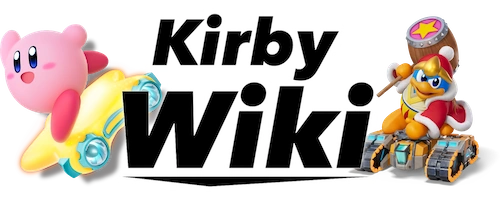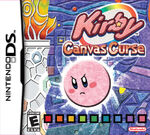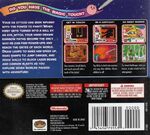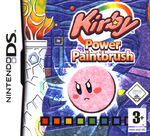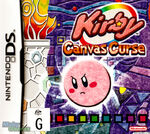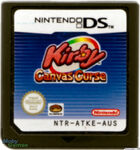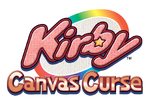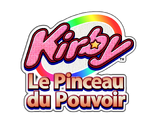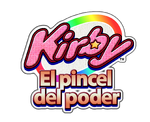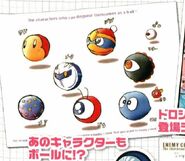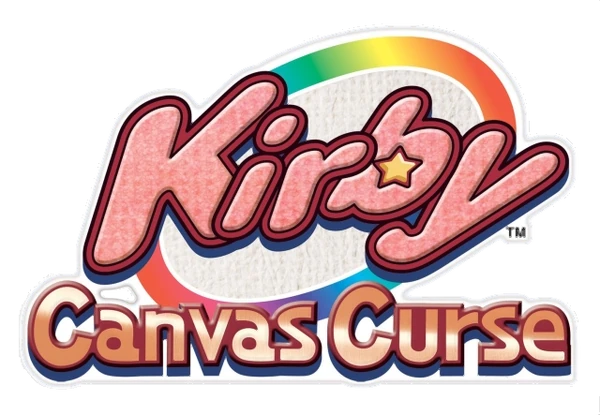| “ | In this unique adventure, Kirby followed the rainbow line that the player drew on the Touch Screen with his or her stylus. The rainbow line could also be used to shield Kirby from attacks, but Kirby wasn't the only star of this game. Other familiar characters made appearances as playable characters too!” |
| — Summary • Kirby's Dream Collection Special Edition |
Kirby: Canvas Curse (sometimes written Kirby Canvas Curse and known in English-speaking parts of Europe as Kirby: Power Paintbrush) is a platformer Kirby game developed by HAL Laboratory and published by Nintendo for the Nintendo DS. It was released in Japan on March 24, 2005, in North America on June 13, 2005, in Europe on November 25, 2005, and in Australia on April 6, 2006.
The game saw re-release for the Wii U Virtual Console platform in PAL regions and in Europe on December 3, 2015 and in Japan and North America on February 3, 2016 and on October 13, 2016, respectively. Kirby: Canvas Curse also received a sequel/successor called Kirby and the Rainbow Curse for the Wii U in 2015.
Story
One day, a strange portal appears in the sky, and out of it comes a witch named Drawcia. Drawcia casts a spell over Dream Land, turning it into a world of paint. Upon fleeing back into the portal she came through, Kirby gives chase, eventually finding himself in Drawcia's also paint-themed world. The witch curses Kirby, turning him into a limbless ball. After Drawcia escapes, the Magical Paintbrush turns to the player to help Kirby. The player and Kirby set off to find and defeat Drawcia to restore Dream Land to its normal state.
Gameplay
Kirby: Canvas Curse is a platformer with a recurring paint motif. It does not play like a traditional Kirby video game, as it uses the stylus exclusively and no use of the face buttons on the Nintendo DS. The player takes control of a magical paintbrush (the DS stylus), and helps guide Kirby or one of four other playable characters on a quest to defeat Drawcia and restore Dream Land to peace. The objective is to progress through each level to reach a rainbow-colored doorway.
Unlike most previous Kirby games, the player does not directly control Kirby with a +Control Pad, analog stick, face buttons, or shoulder buttons. Instead, the player only uses the stylus and touch screen to control Kirby. The player can draw rainbow lines, which Kirby will roll on, or poke Kirby, to make him do a little speed dash. These rainbow paths can form ramps or bridges for Kirby to cross, or walls to protect him from enemy projectiles. Drawing paths depletes the player's rainbow ink supplies, which recharges slowly while Kirby is in the air or on a path, but quickly when Kirby is on the ground. These paths eventually disappear, even faster if another path is painted. However, the player must either tap on Kirby to cause him to dash forward onto the path, or have the path created directly underneath him, causing him to automatically move forward on it. Occasionally, Kirby will come across a barrier, which prevents the paint lines from being created inside of them, forcing Kirby to do nothing but roll, dash, and use a power (if applicable).
The player can use the stylus to stun enemies by tapping on it. Afterward, the player can either allow Kirby to roll into the enemy with his own momentum or by dashing to defeat the enemy. Defeating certain kinds of enemies by either dashing into them or touching them while stunned causes Kirby to gain one of several special Copy Abilities, which may be used at any time by tapping Kirby himself. This special ability replaces the dash. Once an ability is obtained, the only way Kirby can lose it is either by tapping a button in the bottom left corner or by being damaged.
At the end of each world except for world seven, Kirby must face a boss. In worlds one through six, the first time he completes them, he must face one of each boss - Paint Roller, Kracko, or King Dedede (all of whom must be battled twice). With the exception of the final boss, all bosses are sub-game based. The boss of world eight is the main villain of Kirby: Canvas Curse, Drawcia Sorceress.
Portions of the game can be played in Rainbow Run mode, which is unlocked in Medal Swap. In Rainbow Run, fast speed (Time Trial) and limiting the amount of paint used (Line Trial) are key factors in the player's success, awarding Kirby with Medals if he achieves the goal.
Modes
Main Games
- Story Mode
- Rainbow Run
- Time Trial
- Line Trial
Boss games
Medal Swap
| “ | Use the medals you earned in the Main Game and in Rainbow Run to get prizes hidden inside blocks.” |
| — Medal Swap • Kirby: Canvas Curse Instruction Booklet |
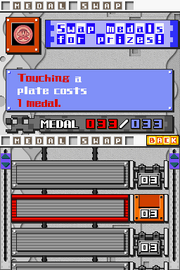
One of the goals of the game is to collect a total of 250 hidden Medals. Many are found hidden in the main game, while others are earned by beating scores in Rainbow Run, getting an A rank in level 3 of a Boss game, or by beating the game with different characters.
The game features a Medal Swap, where medals can be traded for health upgrades, new stages for Rainbow Run, new styles of ink for their stylus, new characters, and an option which replaces all the in-game music with songs from Kirby: Nightmare in Dream Land.
Features unlocked through medal swap:
- Music for Sound Test
- Playable characters
- Health boost
- New courses for Rainbow Run
- New ink styles for the Magic Paintbrush
Characters
Playable Characters
Each character in Kirby: Canvas Curse has a different property. Kirby is the only character whose max HP can be increased. Waddle Dee is faster than Kirby, but can't copy abilities. Waddle Doo permanently uses Beam. King Dedede has a hard-hitting hammer attack and the highest HP out of any character, but is very slow and heavy. Meta Knight has his signature sword attack and is fast and light, but has only three health.
| The following section contains transcluded content from the Database. Source: (view • edit • help) |
Enemies
Bang-Bang | Blado | Blipper | Bloon | Bobo | Bomber | Bouncy | Bronto Burt | Cappy | Chilly | Como | Flame Shotzo | Flamer | Fluff Waddle Dee | Gaveela | Glunk | Gordo | Kabu | Needlous | Pacto | Painting | Para Matter | Rocky | Shotzo | Snoppy | Soarar | Sparky | Spear Waddle Dee | Squishy | Thudd | Tick | Topper | Twister | Waddle Dee | Waddle Doo | Wheelie
Bosses
King Dedede | Kracko | Paint Roller | Drawcia | Drawcia Soul
Copy Abilities
Balloon |
Beam |
Burning |
Crash |
Freeze |
Missile |
Needle |
Spark |
Stone |
Tornado |
Wheel |
Items and Objects
| The following section contains transcluded content from the Database. Source: (view • edit • help) |
Medal | Power Paintbrush | Star | Vitality
Levels
Kirby: Canvas Curse spans eight levels, with all but the last one having three stages:
- Reddy Land
- Arange Gorge
- Iello Adventure
- Neo Greo
- Bloo Hills
- Omarine Zone
- Wonder Lilane
- The World of Drawcia
Music
| Main article: Kirby: Canvas Curse/Music |
Glitches
| Main article: Glitch#Kirby: Canvas Curse |
Reception
Kirby: Canvas Curse has received positive critical acclaim since its release, holding a critical score of 86 on Metacritic[4] and 87.34% on Game Rankings based on 61 reviews.[5] 1UP called it "genuinely excellent", saying that "it's a welcome reinvention of gaming's most overplayed genre" and later concluded that Kirby: Canvas Curse is "the DS's first great game". The stylus gameplay has also been noted, with IGN hailing it as "incredibly innovative", GameSpy saying it is "quite rewarding", and GameSpot calling it is "a satisfying part of the gameplay."
The game has drawn its criticism however, with a few sources claiming that although the game was innovative, it was not especially entertaining, with Play Magazine editor noting that "It's innovative... but for me, that's not enough."
Transcript
| Main article: Kirby: Canvas Curse/Transcript |
Staff
| This section is currently under construction | |
Trivia
- Kirby: Canvas Curse contains a built-in PictoChat search function. When enabled, the player's Nintendo DS will look for other Nintendo DS systems that have activated PictoChat while still allowing the player to play Kirby: Canvas Curse--an orange icon will appear in the top-left corner of the screen if the search is successful. If the player taps this icon, his/her Nintendo DS will power down, reboot, and activate PictoChat.
- This is the first game since Kirby 64: The Crystal Shards where abilities do not grant hats to Kirby.
- During the credits, the player can cause the Portraits of the characters to fall by simply tapping them with the stylus.
- All the music in each level is a remix of a song from a previous game with the exception of a few such as Drawcia's themes and The World of Drawcia.
- All of the first letters in the names of the levels with the exception of The World of Drawcia form an acrostic (Reddy Land, Arange Gorge, Iello Adventure, Neo Greo, Bloo Hills, Omarine Zone, and Wonder Lilane), which spells out "Rainbow."
- This is the second time in the series in which the level names form an acrostic; the others since have been Kirby's Return to Dream Land, Kirby's Dream Collection Special Edition, Kirby: Triple Deluxe, Kirby: Planet Robobot, and Kirby Star Allies.
- This also occurs in Kirby's Adventure / Kirby: Nightmare in Dream Land, where the worlds spell "ROY G. BIV" (an acronym for remembering the colors of the rainbow), but backwards.
- The title screen occasionally changes color from white to turquoise.
- In the Nintendo 3DS StreetPass Mii Plaza game Monster Manor, the Haunted Painting enemy that appears occasionally uses an attack called "Canvas Curse."
- Concept artwork seems to suggest that additional playable characters were considered for Kirby: Canvas Curse; these characters include Lololo & Lalala, Zero, Dark Matter, and Nightmare's Power Orb form. Other pieces of concept art reveal that Drawcia and the Magical Paintbrush went through several designs, and that a three-headed dragon was considered as a boss near the end of the game.[6]
- A pink Nintendo DS stylus was included as a physical extra with all Japanese retail copies of the game. This bonus was omitted from its releases in other regions.
- Kirby: Canvas Curse holds the distinction of being the Kirby game released closest to the launch of its target system. It was released in Japan on March 24, 2005, 124 days after the launch of the Nintendo DS.
- Kirby: Canvas Curse is the only Kirby game to receive a commercial produced by KCL Productions, a mascot costume manufacturer. In the commercial, Kirby and a large, walking finger named Finger go on an adventure through a city before following a rainbow path.[7]
Artwork
Box Art
Media
Logo
Concept Artwork
External links
References

|
This page uses content from Wikipedia. The original page was at Kirby: Canvas Curse. The list of authors can be seen in the page history. Like Kirby Wiki, the text of Wikipedia uses the CC-BY-SA 3.0 license. |
